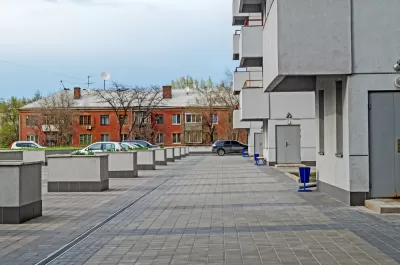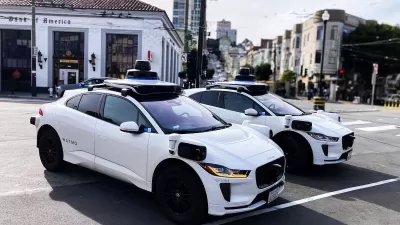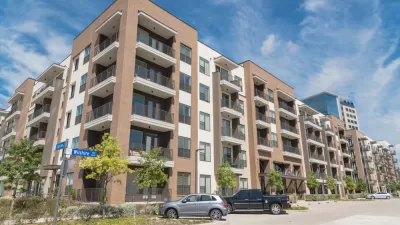Leading researchers debate whether more compact urban development reduces automobile travel in the Journal of the American Planning Association. The issues are complex and important.

Compact development is often recommended as a way to get people to drive less and create more sustainable communities. However, different studies over the years have yielded different outcomes, leading to a muddled understanding about the true impact of compact development. After using meta-aggression analysis, Mark R. Stevens of the University of British Columbia, concludes that planners should not rely on compact development as their only strategy for reducing driving, as it doesn’t have much of an impact.
In the article, "Does Compact Development Make People Drive Less?" in the Journal of the American Planning Association (Vol. 83, No. 1), Stevens looks at nearly 20 years of research and the different outcomes from measuring changes to one of the five features of compact development referred to as the “D-variables” — density, diversity, design, destination accessibility, and distance to transit. He writes that his analysis is the first step in reducing the confusion generated from the multitude of studies and helps improve the understanding of compact development’s influence on driving.
Stevens concludes that planners “should probably not assume that compact development will be very effective” in achieving the goal of reducing driving. “At minimum, planners and municipal decision makers should not rely on compact development as their only strategy for reducing VMT (vehicle miles traveled) unless their goals for reduced driving are very modest and can be clearly achieved at a low cost.”
Stevens’s research has ignited a passionate debate over compact development’s true impacts. Reid Ewing and Robert Cervero, professors at the University of Utah and the University of California, Berkeley, co-authored one of the most cited JAPA articles about compact development. They comment that their greatest concern is that Stevens has overreached in his conclusions.
Susan Handy, professor at the University of California, Davis, comments that compact development cannot reduce driving very much on its own, but we cannot reduce driving very much without it. She writes that communities need to make it possible to drive less, help people understand how to drive less, and make people want to drive less.
Michael Manville, assistant professor at UCLA Luskin School of Public Affairs, adds his voice to the mix. He comments that planners should focus instead on the free land provided to cars instead of studying the 5Ds. “Travel’s influence on the built environment is a function of the built environment designed for travel. We should stop pretending otherwise.”
Gerrit-Jan Knaap and Uri Avin, FAICP, professors at the University of Maryland, College Park, and PhD candidate Li Fang, comment that Stevens’s revelation about compact development is not new. “There is nothing wrong with his conclusion that if planners want to reduce VMT they should not expect to have much influence through changing urban form. But in many respects this conclusion is nearly obsolete.”
Arthur Nelson, FAICP, professor at University of Arizona and Presidential Professor Emeritus at the University of Utah, comments that “it is possible that planners do not know how to apply insights of statistical analysis such as those that Stevens references and synthesizes.” He concludes that it is time for the insights of researchers referenced by Stevens, and Stevens himself, to be made accessible to planners.
FULL STORY: Study Sparks Debate Over Relationship Between Compact Development and Driving

Planetizen Federal Action Tracker
A weekly monitor of how Trump’s orders and actions are impacting planners and planning in America.

Congressman Proposes Bill to Rename DC Metro “Trump Train”
The Make Autorail Great Again Act would withhold federal funding to the system until the Washington Metropolitan Area Transit Authority (WMATA), rebrands as the Washington Metropolitan Authority for Greater Access (WMAGA).

The Simple Legislative Tool Transforming Vacant Downtowns
In California, Michigan and Georgia, an easy win is bringing dollars — and delight — back to city centers.

The States Losing Rural Delivery Rooms at an Alarming Pace
In some states, as few as 9% of rural hospitals still deliver babies. As a result, rising pre-term births, no adequate pre-term care and harrowing close calls are a growing reality.

The Small South Asian Republic Going all in on EVs
Thanks to one simple policy change less than five years ago, 65% of new cars in this Himalayan country are now electric.

DC Backpedals on Bike Lane Protection, Swaps Barriers for Paint
Citing aesthetic concerns, the city is removing the concrete barriers and flexposts that once separated Arizona Avenue cyclists from motor vehicles.
Urban Design for Planners 1: Software Tools
This six-course series explores essential urban design concepts using open source software and equips planners with the tools they need to participate fully in the urban design process.
Planning for Universal Design
Learn the tools for implementing Universal Design in planning regulations.
Smith Gee Studio
City of Charlotte
City of Camden Redevelopment Agency
City of Astoria
Transportation Research & Education Center (TREC) at Portland State University
US High Speed Rail Association
City of Camden Redevelopment Agency
Municipality of Princeton (NJ)





























